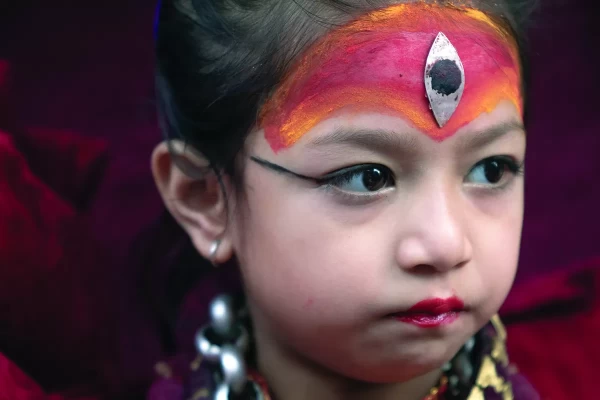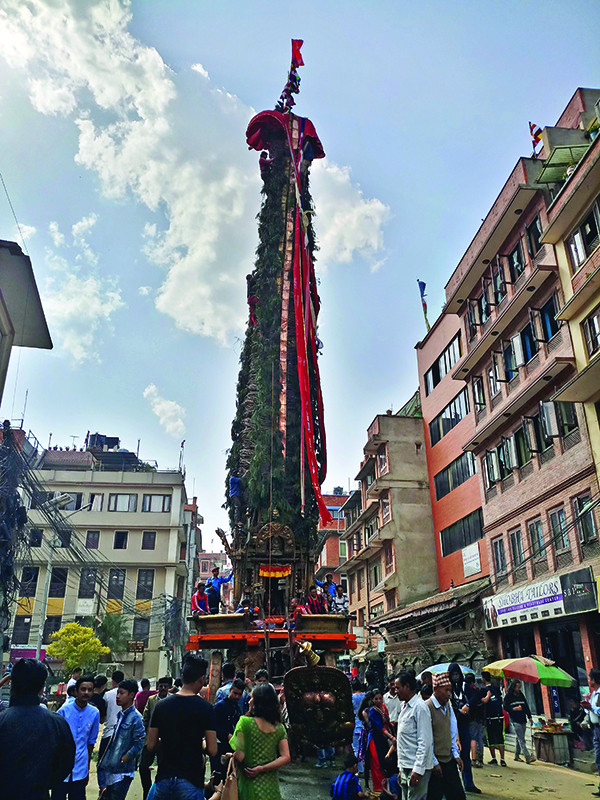The Kumari and the Bungadyo Jatra

Every year as the summer starts to descend over the Kathmandu valley, the city of Patan gears up for its favorite festival, the Rato Macchindranath Jatra. Each year, the festival, also known as the Bungadyo Jatra is celebrated in late April to May where a 40 foot tall chariot is pulled by dozens through the streets of Patan among loud music, dance and a ton of devotees and spectators. This festival is so popular that the Lalitpur Metropolitan City office has adapted the chariot as its official logo.
But the tall chariot and its smaller counterpart, the chariot of Chukadyo or Minnath is just one aspect of the festival. While the festival continues with its zeal and celebrations, the Kumari of Patan graces her presence each time the chariot is pulled through the streets. The tradition of the young living goddess, Kumari attending the festival of the Bungadyo is one that dates back to the time of the Malla kings in the 12th century. The Malla kings revered the small girl as a reincarnation of their dynasty’s clan deity, goddess Taleju. Thus, the Kumari would sit beside the Malla kings of Patan as the Bungadyo festival processed. This tradition has survived through the centuries and even through the downfall of the monarchy in Nepal. To this day, each time the festive chariot of the Bungadyo and Chukadyo is pulled, you will spot the Kumari seated in a pati, a traditional pavilion nearby, surrounded by her family and devotees.
You may also like: Attractions of Patan beyond Mangalbazar
 It is rare to spot the Kumari in public as she spends most of her time in her residence in Ratnakar Mahavihar. Thus, every time the Kumari makes her presence in the public eye, her devotees will queue up to touch her feet and receive blessings. It is not just her devotes who are enraptured by her mysterious, emotionless expression and her patience to sit still for hours. Photographers and tourists equally share the curiosity and can be seen hovering around the small living goddess, trying to snap the best picture against the massive crowd surrounding her.
It is rare to spot the Kumari in public as she spends most of her time in her residence in Ratnakar Mahavihar. Thus, every time the Kumari makes her presence in the public eye, her devotees will queue up to touch her feet and receive blessings. It is not just her devotes who are enraptured by her mysterious, emotionless expression and her patience to sit still for hours. Photographers and tourists equally share the curiosity and can be seen hovering around the small living goddess, trying to snap the best picture against the massive crowd surrounding her.
Following the route of the jatra, the Kumari can be spotted sitting patiently in the designated pati wherever the Bungadyo’s chariot passes by. The Bungadyo chariot starts from Pulchowk and makes its way to Gabahal on the first day. Then the next day, it moves from Gabahal to Mangal Bazaar; Mangal Bazaar to Sundhara and then Sundhara to Tangal. From Tangal, the chariot is taken to Lagankhel where it spends a couple of days and then follows the path about a few hundred meters back to Thati tole then Iti tole and finally about a month later, the chariot is pulled for its final stretch from Iti tole to Jawalakhel.
At Jawalakhel, the Bhoto Jatra commences, where once again, the Kumari is dutifully presented in her place, clad in her ceremonial red attire and traditional jewelry with a distinctive metal “third eye” placed on her forehead. While the rest of the patis in Patan also function as a rest stop for the locals and is accessible to the public throughout the rest of the year, the pati where the Kumari sits to watch the festival processions from Iti tole to Jatra has been successful in officially naming the street itself as “Kumaripati” and only the Kumari is allowed to use it during the festivals.
The next time you get a chance to attend the Bungadyo Jatra, try to spot the Kumari sitting patiently on her pati nearby. You cannot miss the large gathering of people around the living goddess, the only rightful distraction against two giant chariots being pulled by hundreds of people.
